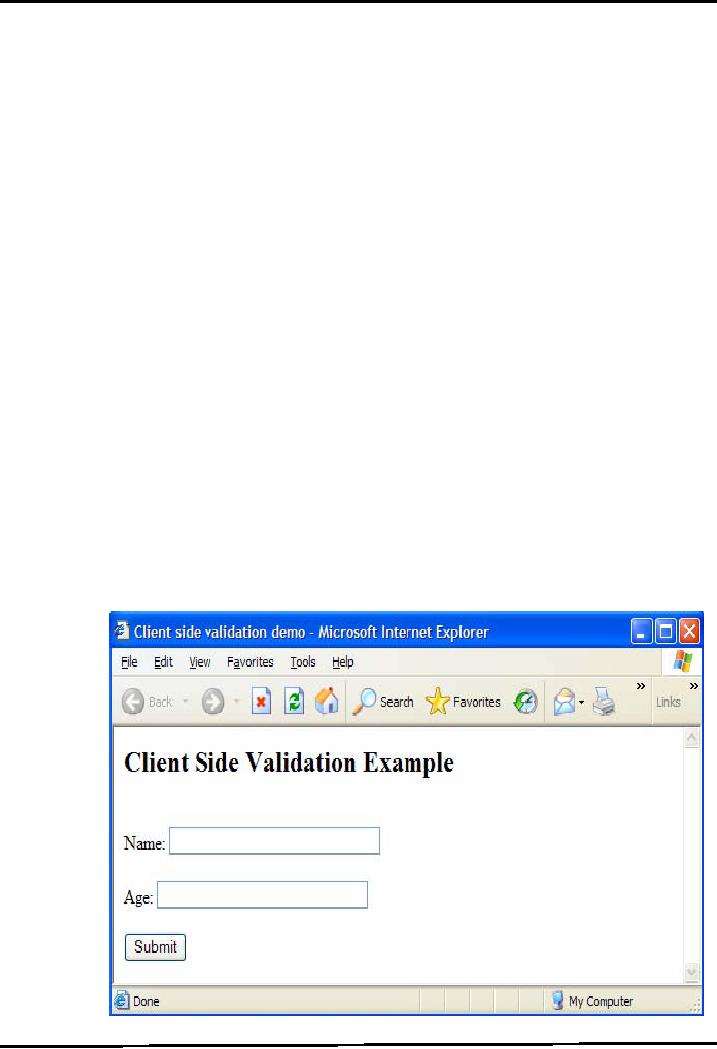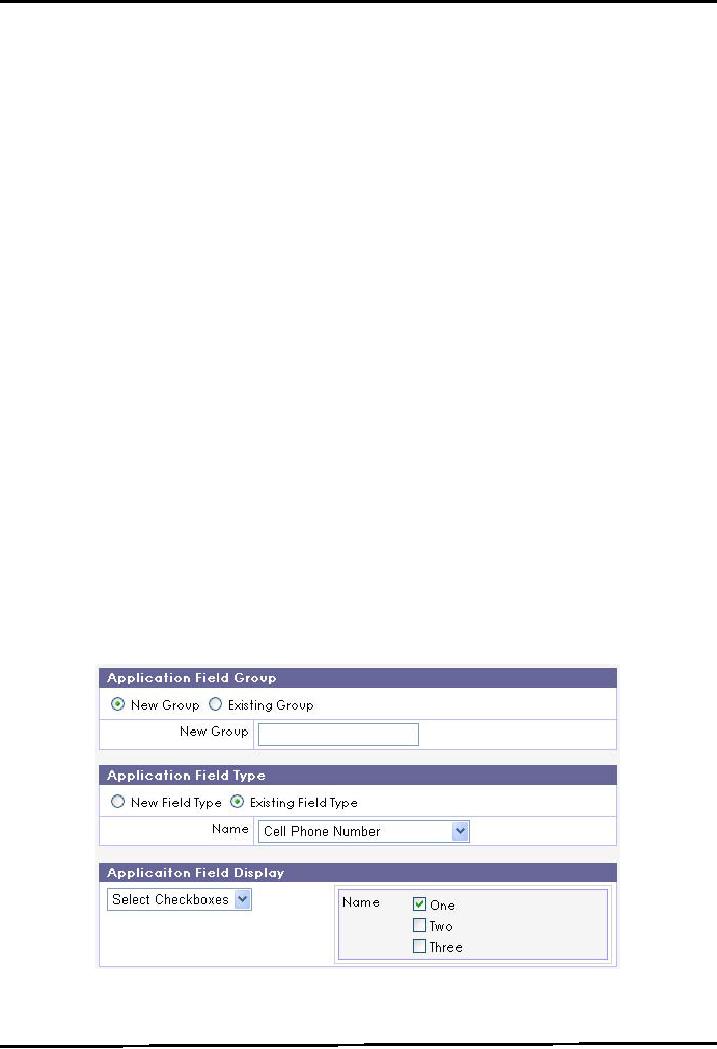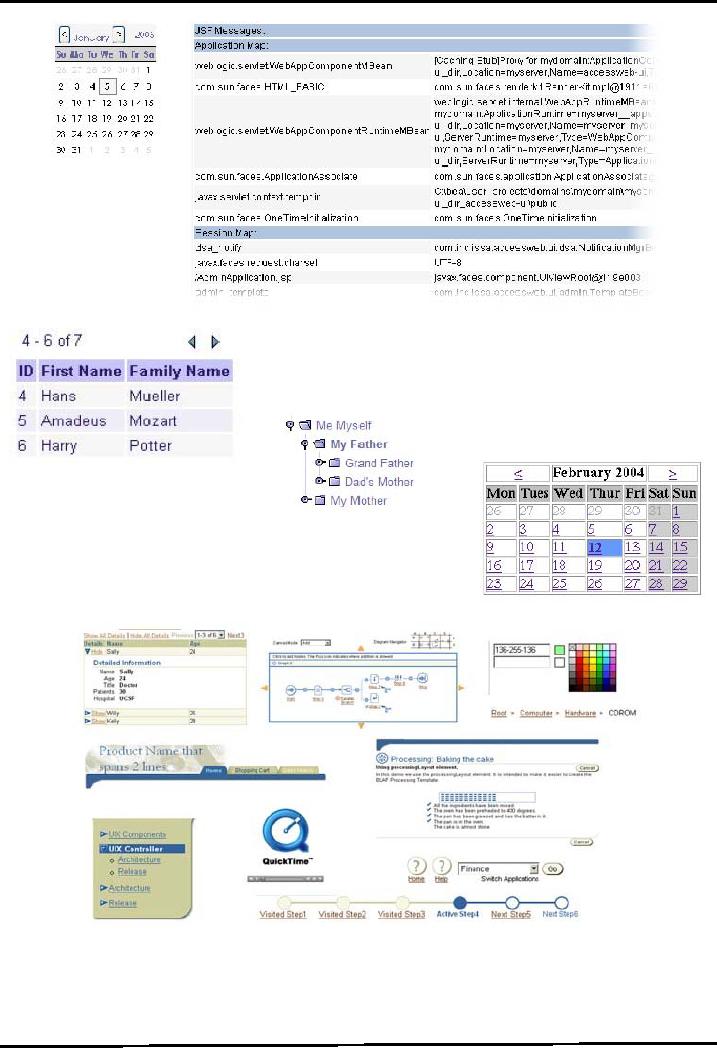 |
JAVA: Client Side Validation & JavaServer Faces (JSF) |
| << JAVA: JavaServer Pages Standard Tag Library (JSTL) |
| JAVA: JavaServer Faces >> |

Web
Design & Development CS506
VU
Lesson
44
Client
Side Validation & JavaServer
Faces (JSF)
In
this handout, we'll talk
about client side validation
and also learn about growing
in demand Java
technology
i.e. JSF. First start
with client side
validation
Client
Side Validation
Forms
validation on the client-side is
essential --it saves time
and bandwidth, and gives you more
options
to
point out to the user where
they've gone wrong in filling
out the form. Furthermore, the browser
doesn't
have to
make a round-trip to the server to
perform routine client-side
tasks. For example, you
wouldn't want
to
send the browser to the server to
validate that all of the
required fields on a form were
filled out.
Any
scripting language can be used to achieve
the said objective. However, JavaScript
and VBScript are
two
popular options
Why is
Client Side Validation
Good?
There
are two good reasons to
use client-side
validation:
It's
a fast form of validation: if something's
wrong, the alarm is triggered
upon submission of the
form.
You
can safely display only one
error at a time and focus on the wrong
field, to help ensure that
the
user
correctly fills in all the
details you need.
Code
Example: Form Validation
using JavaScript
For
example on the following form, we
want to make sure that
text filed for name
should not be left
empty
and
age field does not
contain any negative value.
To accomplish this we'll use
JavaScript.
If
user forgets to provide name
and/or enters a negative
value, a message would be
displayed to the user
that
indicates what was went
wrong? However, if user conforms to
requirements, he/she would be taken
to
another
page that displays a
greeting message.
351

Web
Design & Development CS506
VU
Note: In
this example, JavaScript semantics
isn't discussed over here as
I am assuming that you might
be
familiar
with some scripting language.
Otherwise, www.w3schools.com
is an
excellent resource to
learn
about scripting
languages
The
code that is used to
generate this page is given
below:
<HTML>
<HEAD>
<!--
start of scripting code and
mentioning type
-->
<SCRIPT
TYPE = "text/javascript">
<!--
defining a function that
receives form's reference, defined
inside the body and returns
false
if
any
requirement violated
-->
function
validateForm(thisform)
{
<!--
checking the value of the name
field, if it is left empty then
displaying a message
-->
if
(thisform.name.value == null ||
thisform.name.value == "")
{
alert("Username
is required");
return
false;
}
<!-- if
value of age is negative,
displaying a message
-->
if
(thisform.age.value < 0 )
{
alert("Age
can't be negative");
return
false;
}
} // end of
function
</SCRIPT>
<!--end of script-- >
</HEAD>
<!--
validateForm method is called and
specified as a value of onsubmit
value, if this method returns
false, the
user remains on the same
page -->
<FORM
method="post" onsubmit="return
validateForm(this)" action =
"greeting.jsp" >
<h2>
Client Side Validation
Example </h2>
<BR/>
Name:
<INPUT type="text" name="name"
size="30" />
<BR/>
<BR/>
Age:
<INPUT type="text" name="age"
size="30" />
<BR/>
<BR/>
<INPUT
type="submit" value="Submit">
</FORM>
</BODY>
</HTML>
JavaServer
Faces (JSF)
JSF
technology simplifies building
the user interface for web
applications. It does this
by
providing
a higher-level framework for
working with your web
applications. Some
distinct
352

Web
Design & Development CS506
VU
features
will be discussed provided by this
technology. To begin with,
have a look on some
popular
existing frameworks
Different
existing frameworks
Struts
A
popular open source JSP-based Web
application framework helps in defining a
structured
programming
model (MVC), also validation
framework and reduces tedious
coding but...
Adds
complexity and doesn't provide UI
tags
Very
Java programmer centric
Tapestry
Another
popular framework that is
extensively used in the
industry is Tapestry. It
has
almost
similar sort of problems as
with Struts.
JavaServer
Faces
A
framework which provides
solutions for:
Representing UI
components
Managing
their state
Handling
events
Input
validation
Data
binding
Automatic
conversion
Defining
page navigation
Supporting
internationalization and
accessibility.
If
you are familiar with
Struts and Swing (the standard
Java user interface framework
for desktop
applications),
think of JavaServer Faces as a
combination of those two frameworks.
Like Swing,
JSF
provides a rich component
model that eases event
handling and component rendering;
and
like
Struts, JSF provides Web
application lifecycle management
through a controller
servlet
JSF UI
Components
Some
of the standard JavaServer Faces
components are shown
below:
Some
custom JavaServer Faces components
are
353

Web
Design & Development CS506
VU
And
some open course JavaServer Faces
components are also
available like:
And
some third-party JavaServer Faces
components are also
available:
A JSF
application works by processing
events triggered by the JSF
components on the pages. These
events
are
caused by user actions. For
example, when the user
clicks a button, the button
triggers an event.
You,
the
JSF programmer, decide what the JSF
application will do when a
particular event is fired.
You do this
by
writing event listeners. In other words,
a JSF application is
event-driven
354

Web
Design & Development CS506
VU
For
example, if you write a JSF
code to create a button, you
will write:
<h:commandButton
value="Login"
actionListener="#{customer.loginActionListener}"
action="#{customer.login}"
/>
The
value attribute specifies the text
that appeared on the face of a
button, the actionListener
attributes
specifies to
call the loginActionListener method
written somewhere in a Customer
class if an event is
triggered
and on which to go next, is decided by the
login method of Customer class
and given as a value
of
action
attribute. The method specified in
action attribute should
return a String value as the
returned
Stringvalue
is used in page
navigation.
Note:
Many IDE provides visual
support for JSF so you can
drag and drop components instead of
writing
tedious
coding for defining JSF
components as shown above. Sun
Studio Creator� is a free
open
source
IDE that provides visual
support for JSF and can be
downloaded form Sun site.
The code
examples
are also built using
this IDE.
A
code snippet of a Customer
class is given below:
class
Customer {
public
void loginActionListener(ActionEvent e)
{
.....................
}
public
String login() {
return
"OK";
}
}
Example
Code: Hello User
The
example code ("hello user
1") is given along with the
handout. It is strongly advised that
you must see
the
lecture video in order to
learn how this example is
built.
User
will provide a name in the
text field and his/her name
after appending "hello" to
it, would be
displayed
on the same page.
Validators
make input validation simple and
save developers hours of programming. JSF
provides a set of
validator
classes for validating input
values entered into input components.
Alternatively, you can
write
your
own validator if none of the standard
validators suits your needs.
Some built-in validators
are:
DoubleRangeValidator
Any
numeric type, between specified
maximum and minimum values
LongRangeValidator
Any
numeric type convertible to
long, between specified maximum and
minimum values
LengthValidator
Ensures
that the length of a component's
local value falls into a
certain range (between
minimum
&
maximum). The value must be
of String type.
Example
Code: Hello User
The
example code ("hello user
2") is given along with the
handout. You can open it
using Sun Studio
Creator
IDE. It is strongly advised that
you must see the lecture
video in order to learn how
this example is
built.
It is
actually a modified version of the last
example. This time, we'll
make sure that user couldn't
left blank
the
name field and must enter a
name between ranges of 2 to 10
characters. If any condition
fails, an
appropriate
message would be
displayed.
355

Web
Design & Development CS506
VU
JSF
Managed Bean-Intro
These
are JavaBeans defined in the
configuration file and are
used to hold the data from
JSF components.
Managed
beans represent the data
model, and are passed between
business logic and pages.
Some other
salient
features are:
Use
the declarative model
Entry
point into the model and
event handlers
Can
have beans with various
states
Here
is an example of a managed-bean element
whose scope is session,
meaning that an instance of
this
bean
is created at the beginning of a user
session.
<managed-bean>
<managed-bean-name>myBean</managed-bean-name>
<managed-bean-class>myPackage.MyBean</managed-bean-class>
<managed-bean-scope>session</managed-bean-scope>
</managed-bean>
JSF
Value Binding
Value
binding expressions can be
used inside of JSF
components to:
Automatically
instantiate a JavaBean and place it in
the request or session
scope.
Override
the JavaBean's default values through
its accessor methods.
Quickly
retrieve Map,
List,
and array contents from a
JavaBean.
Synchronize
form contents with value
objects across a number of
requests.
The
syntax of binding expressions is
based on the JavaServer Pages (JSP)
2.0 Expression Language. In
JSP,
expressions are delimited
with "${}", but in JSF
they are delimited with
"#{}".
JSF
Method Binding
Unlike
a value binding, a method binding
does not represent an
accessor method. Instead, a method
binding
represents
an activation method.
For
example, binding an event
handler to a method
<h:commandButton
......
actionListener="#{customer.loginActionListener}"
.........
/>
JSF
Navigation
Page
navigation determines the control flow of
a Web application. JSF provides a
default navigational
handler
and this behavior can be
configured in configuration. However,
you can do it visually in
most tools
like
Sun Studio Creator
Note: We have
quickly breezed through the
JSF technology essentials due to
shortage of time. You
must
explore
it by yourself to excel on it.
You can find the resources
in the last handout to acquire further
skills.
References:
Java
A Lab Course by Umair
Javed
Intrduction
to JavaServer Faces by Sun
http://java.sun.com
JavaServer
Faces Programming by
Kumiawan
356
Table of Contents:
- JAVA FEATURES
- Java Virtual Machine & Runtime Environment
- Learning Basics of JAVA
- JAVA: Object Oriented Programming
- JAVA: Inheritance
- JAVA: Collections
- JAVA: Intro to Exceptions
- JAVA: Streams
- JAVA: Modification of Address Book Code
- JAVA: Graphical User Interfaces
- JAVA: Event Handling
- JAVA: More Examples of Handling Events
- JAVA: Problem in Last Code Example
- Java Database Connectivity
- JAVA: More on JDBC
- JAVA: Result Set
- JAVA: Meta Data
- Java Graphics
- JAVA: How to Animate
- JAVA Applets
- JAVA: Socket Programming
- JAVA: Serialization
- JAVA: Multithreading 1
- JAVA: Multithreading 2
- JAVA Web Application Development
- Java Servlets
- JAVA: Creating a Simple Web Application in Tomcat
- JAVA: Servlets Lifecycle
- JAVA: More on Servlets
- JAVA: Dispatching Requests
- JAVA: Session Tracking 1
- JAVA: Session Tracking 2
- JAVA: AddressBook Case Study Using Sevlets
- Java Server Pages 1
- JavaServer Pages 2
- Java Server Pages 3
- JAVA: JSP Action Elements and Scope
- JAVA: JSP Custom Tags
- JAVA: MVC + Case Study
- JAVA: MVC Model 2 Architecture
- JAVA: Layers and Tiers
- JAVA: Expression Language
- JAVA: JavaServer Pages Standard Tag Library (JSTL)
- JAVA: Client Side Validation & JavaServer Faces (JSF)
- JAVA: JavaServer Faces